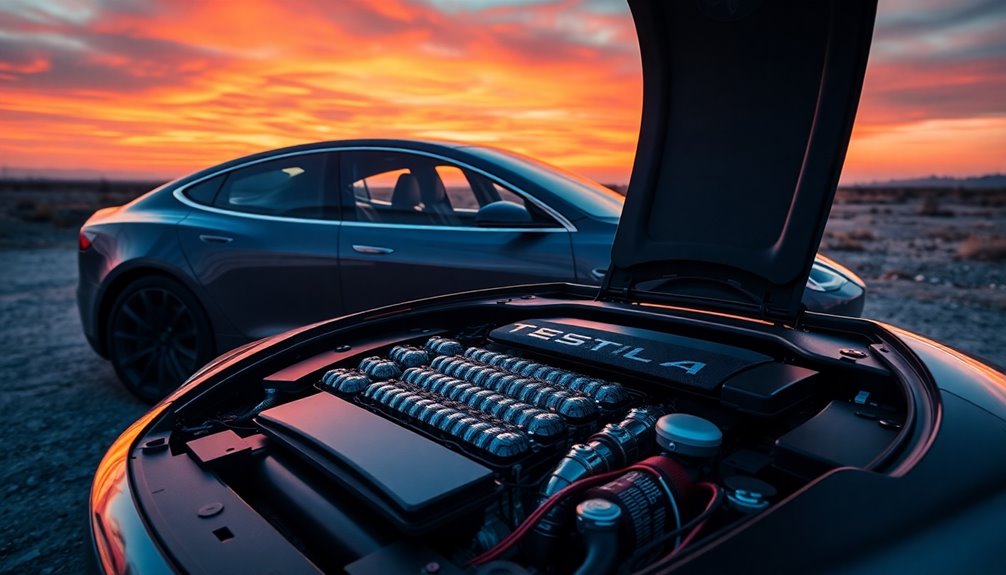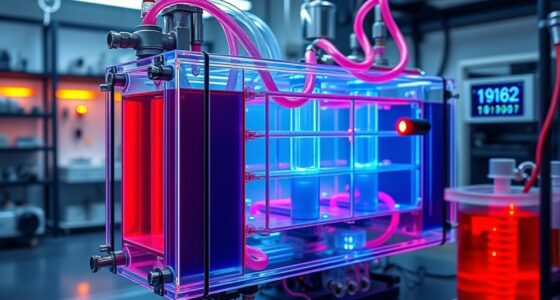A Tesla isn't just one battery; it's a pack filled with thousands of lithium-ion cells. Depending on the model, you might find around 7,104 smaller 18650 cells in the Model S and Model X, or about 4,416 larger 2170 cells in the Model 3 and Model Y. These configurations help optimize performance and range, with the larger packs offering more power. This modular design not only enhances efficiency but also allows for easier repairs. Curious about how this affects overall performance and what innovations are on the horizon? There's plenty more to explore!
Key Takeaways
- Tesla vehicles utilize thousands of lithium-ion cells, with configurations including 18650 and 2170 cell formats.
- The Model S and Model X contain approximately 7,104 18650 cells, while the Model 3 and Model Y have around 4,416 2170 cells.
- Battery capacity varies by model, with the Model S offering up to 100 kWh and the Model 3 ranging from 50 kWh to 75 kWh.
- Each battery pack is divided into modules for improved thermal management and overall safety during operation.
- Tesla continuously evolves its battery technology to enhance performance, safety, and efficiency across all models.
Understanding Tesla's Battery Pack Structure
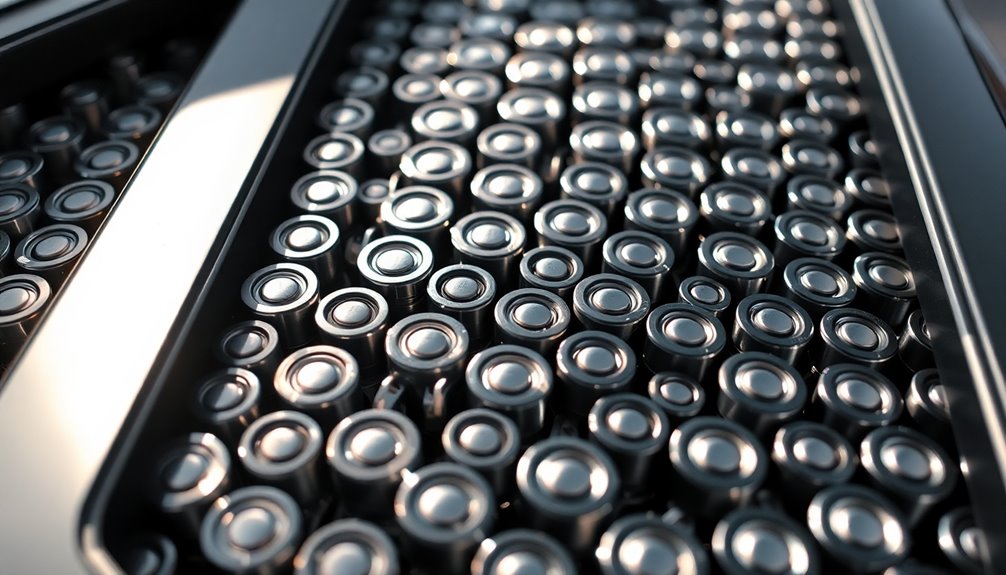
When you look under the hood of a Tesla, you'll find a complex battery pack structure designed for efficiency and performance.
The Tesla battery packs consist of thousands of individual lithium-ion cells, tailored to maximize energy density and thermal management. For instance, the Model S's 85 kWh pack features around 7,104 cells, primarily in the 18650 format.
Newer models like the Model 3 and Model Y have shifted to the larger 2170 cells, enhancing performance further. Each battery pack is divided into modules, promoting better thermal management and safety by isolating potential issues.
The arrangement and number of cells directly affect your electric vehicle's range, charging speed, and overall efficiency, showcasing Tesla's commitment to continuous innovation in battery technology.
Number of Battery Cells Explained

The number of battery cells in Tesla vehicles plays a significant role in their performance and energy capacity. For instance, the Model S and Model X utilize around 7,104 18650 cells, while the Model 3 and Model Y feature 4,416 larger 2170 cells. This difference enhances energy density and efficiency, contributing to powerful battery packs—85 kWh for the Model S and 75 kWh for the Model 3 Long Range. Owners often report minimal degradation, prolonging the need for battery replacement. Additionally, the integration of these battery cells guarantees safety, preventing thermal runaway and providing reliable energy delivery.
| Tesla Model | Number of Battery Cells |
|---|---|
| Model S/X | 7,104 |
| Model 3/Y | 4,416 |
Variations Across Tesla Models
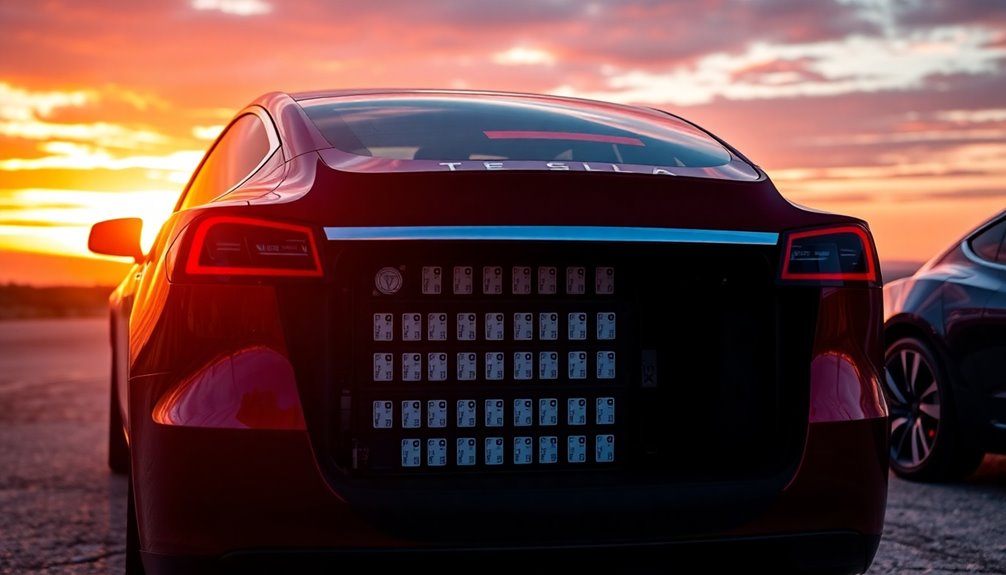
How do the variations in battery configurations impact your Tesla driving experience?
The Tesla Model S and Model X feature large battery packs, typically housing around 7,000 individual 18650 lithium-ion cells. This setup delivers impressive performance and range.
In contrast, the Model 3 and Model Y utilize 2170 cells, with their battery packs containing about 4,416 cells, depending on the version.
The Model S offers battery options like the 85 kWh and 100 kWh packs, while the Model 3's standard range hits around 50 kWh to 75 kWh.
Performance variants often include advanced battery technology, enhancing power and efficiency.
Each model's tailored battery design guarantees peak performance and safety, allowing you to enjoy a unique driving experience with every Tesla.
Benefits of Modular Design
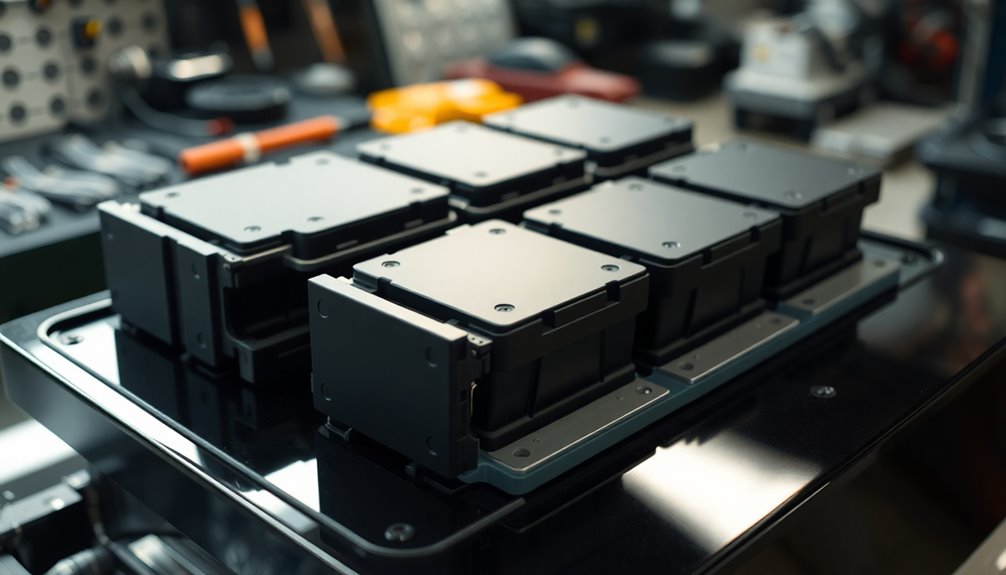
Tesla's modular battery design brings a host of advantages that enhance your driving experience.
This modular design allows for efficient scalability, making it easy to adapt battery packs for various models like the Model S and Model 3. You'll appreciate how each vehicle can contain thousands of 18650 cells arranged in modules, promoting repairability—if a module fails, you can replace just that, not the entire pack.
Additionally, this setup reduces manufacturing costs through economies of scale. It optimizes weight distribution and safety, improving vehicle handling and performance.
Plus, advanced thermal management systems within each module greatly lower the risk of thermal runaway incidents, ensuring a safer driving experience.
These benefits truly set Tesla apart in the electric vehicle market.
Battery Management Systems

While driving a Tesla, you mightn't realize the sophisticated technology working behind the scenes to keep your battery performing at its best.
At the heart of this technology is the Battery Management System (BMS), which monitors the health, charge state, and temperature of each lithium-ion cell. By utilizing advanced algorithms, the BMS prevents thermal runaway and controls both charging and discharging processes.
It oversees thousands of cells—like the 7,104 found in a Model S—ensuring they operate safely within their limits. The BMS also extends battery life by implementing smart charging strategies, limiting full charges to about 80-90%.
Plus, its fault detection capabilities identify and isolate any malfunctioning cells, maintaining the battery pack's integrity and safety.
Impact on Performance and Range
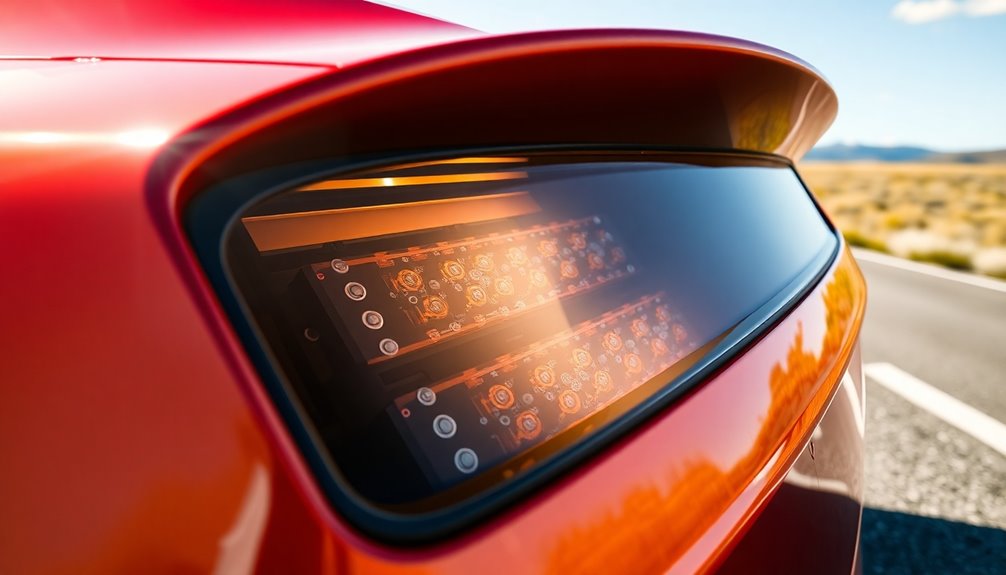
The performance and range of a Tesla are greatly influenced by its advanced battery technology. Each Model S and Model X features a battery pack with approximately 7,104 individual cells, optimizing weight and efficiency. This innovative design enables the Model S to achieve an impressive range of nearly 400 miles on a single charge.
Tesla's advanced thermal management systems help maintain battery performance and safety, directly impacting your vehicle's range and longevity. Additionally, the regenerative braking system allows you to recover energy during deceleration, extending your effective range while reducing wear on brake components.
With only about 12% battery degradation after 200,000 miles, Tesla's batteries guarantee sustained performance and range throughout the life of your vehicle.
Future Innovations in Battery Technology

As advancements in battery technology continue to unfold, you can expect significant innovations that will enhance the performance and sustainability of electric vehicles.
Tesla's heavy investment in next-gen battery technologies includes solid-state batteries, which offer higher energy densities and improved safety. Additionally, new battery chemistries like lithium-silicon and lithium-sulfur are being explored, promising longer-lasting batteries with less degradation.
Innovations in battery recycling processes will also recover valuable materials, aligning with Tesla's sustainability goals. By integrating battery packs in-house, Tesla is boosting manufacturing efficiency, leading to better thermal management and design.
Expect future models to feature faster charging times and increased range, making charging stations more efficient and accessible for your electric vehicle experience.
Owner Experiences With Battery Life
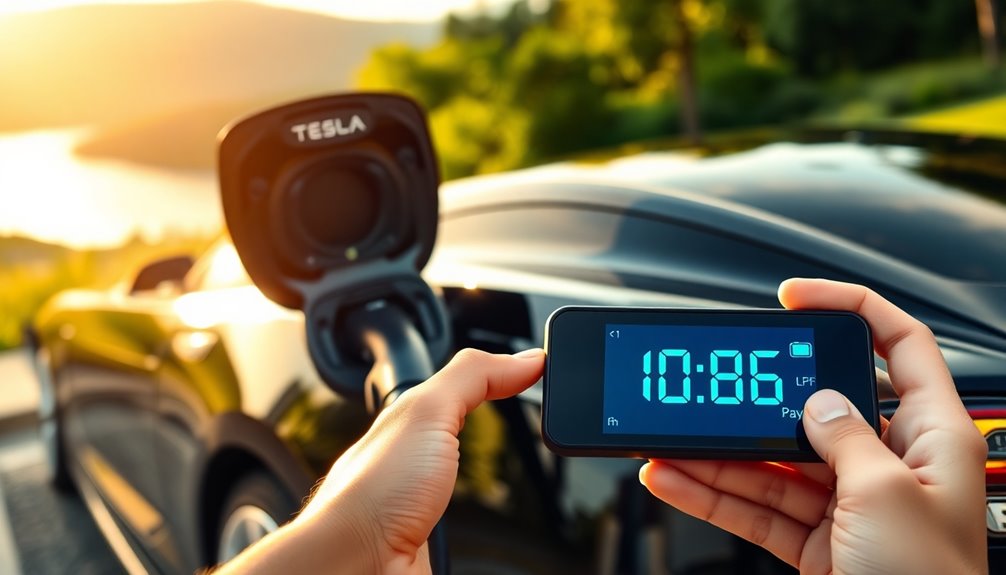
As a Tesla owner, you might be pleasantly surprised by the battery longevity you experience, often seeing minimal capacity loss over time.
Your charging habits play an essential role in maintaining this health, as keeping your battery levels between 20% and 80% can greatly extend its lifespan.
With many drivers reporting impressive mileage without major issues, it's clear that the right practices can lead to a reliable and resilient battery.
Battery Longevity Insights
Many Tesla owners have shared their positive experiences regarding battery longevity, often exceeding initial expectations. Many drivers report impressive results, with some vehicles lasting over 200,000 miles with minimal degradation.
You might be surprised to learn that battery replacements are quite rare, enhancing the appeal of electric cars.
- Initial capacity loss is around 5% within the first 50,000 miles.
- Owners frequently exceed 100,000 miles without significant issues.
- Anecdotal evidence shows some vehicles reaching over 1 million miles.
Proper care and driving habits play an essential role in this, ensuring that your Tesla remains reliable over time.
Charging Habits Impact
While charging habits might seem like a minor detail, they can considerably impact your Tesla's battery life. Most owners charge to less than full capacity, only doing so about twice a month. This practice helps enhance battery longevity.
By keeping your battery levels between 20% and 80%, you not only maintain a healthy range but also avoid stressing the battery. Many owners report rarely allowing their battery to drop below 8 km (5 miles), which contributes to prolonged battery health.
Additionally, avoiding frequent Supercharger use and aggressive driving can further improve performance. Overall, establishing consistent charging routines and mindful habits is key to ensuring your Tesla's battery remains in top shape for years to come.
Frequently Asked Questions
How Many Actual Batteries Are in a Tesla?
When you ask how many actual batteries are in a Tesla, it's important to know that Tesla vehicles use thousands of lithium-ion cells.
For instance, the Model S and Model X have about 7,104 cells, while the Model 3 and Model Y contain around 4,416 cells.
Each cell is part of a module designed to optimize energy distribution and thermal management, ensuring your Tesla runs efficiently and reliably on the road.
How Much Does It Cost to Replace a Tesla Battery?
Imagine your Tesla's battery as a treasure chest, essential for your journey. When it needs replacing, you're looking at a cost between $10,000 and $20,000, depending on the model.
While it's a hefty sum, remember that Tesla's warranty protects you from defects and guarantees your treasure chest won't degrade too much.
With only a few owners facing this situation, you might find creative solutions to keep your treasure intact and your travels smooth.
What Happens if a Tesla Battery Goes to Zero?
If your Tesla battery goes to zero, the vehicle enters sleep mode to protect the battery from damage.
You won't be completely stranded, as there's a reserve capacity that keeps some functionality. However, you'll notice reduced performance and range, so it's essential to charge it soon.
Once it's fully depleted, charging might take longer, and the car may need a moment to wake up after connecting to the charger.
How Many 21700 Batteries Are in a Tesla?
When you think about Tesla's innovative battery technology, you might picture powerful energy cells, efficient designs, and impressive performance.
In Tesla's Model 3 and Model Y, you'll find around 4,416 individual 21700 battery cells. These larger cells enhance energy density, boosting range and efficiency.
Each cell packs a nominal voltage of about 3.7 volts and a capacity of 4,000 mAh, showcasing Tesla's commitment to cutting-edge electric vehicle technology.
Conclusion
In summary, Tesla's battery packs are a marvel of engineering, packed with hundreds to thousands of cells depending on the model. This modular design not only boosts performance and range but also supports future innovations that'll keep your ride ahead of the curve. Think of it like riding a futuristic hoverboard—smooth, efficient, and always ready for the road ahead. So, if you're considering a Tesla, you're truly investing in tomorrow's technology today!

